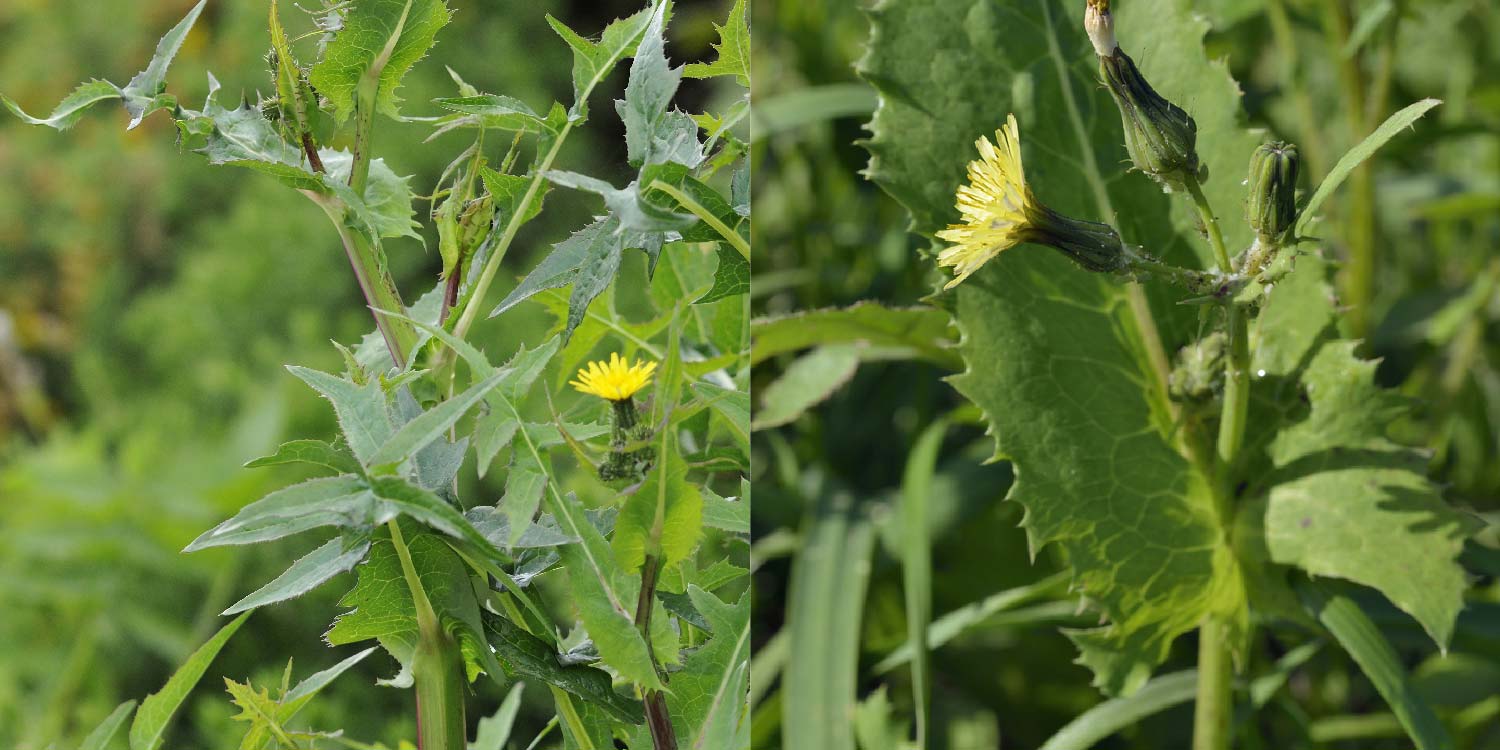Sow thistle (Sonchus oleraceus), which is also known as milk thistle is one of the key weeds in Kenya whose control is of great concern. It is an erect and fleshy plant that possess hollow, smooth stems that exude milky latex when damaged.
Botanical characteristics/ Identification
- Stem
The stems are erect (1-4ft high), hollow, smooth, stout and branchy at the top. They produce milky sap.
- Leaves
The leaves are alternate with spiny and deeply lobed margins. Lower leaves are petiolate while the upper ones are sessile. The leaves have purple veins.
- Flowers
Sow thistle has numerous flower heads which are yellow in color and appear in corymbs.
- Seeds
Seeds are brown, ridged & wriggled with a tuft of fine white hair.
- Roots
It has a tap root system which is upright with many branches.
Ecological requirements
Oleraceus grow on a wide range of climate. It is found on substrates such as Gardens, cultivated lands, roadsides, mountains, near water sources etc. In arid and semi-arid areas, it is found near water ways, ponds, springs etc.
It requires light and thrives well in areas which have no vegetation cover. Seed germination take place at temperatures ranging from 7-35 degrees Celsius. It requires Light (sandy), medium (loamy) & heavy (clay) soils
The weed prefer acidic, neutral and alkaline soils. Moist soils favor its growth (300- 2800mm mean annual rainfall)
Adaptation to environmental conditions.
- Highly adaptable to different environments
- Has propagules that can remain viable for more than a year
- It is a habitat generalists
- Pioneering in disturbed areas
- Abundant in its native range.
- Fast growing
- High reproductive potential
- Benefits from human association(i.e. it is human commensal)
- Leaves are thin, spiked and generally reduced to cope dry climates.
Distribution of sow thistle in Kenya
The ability of sow thistle to survive in varied climatic and ecological conditions makes it thrive in different parts of Kenya. For instance, in the eastern parts, coastal regions, Mt. Kenya areas and some parts of western- Nyanza.
Disadvantages of the crop
Sow thistle is a better competitor than the crop. It takes up water and nutrients thus depriving the crop the same. Competition for light posed to the crop is also a disadvantage since sow thistle will grow tall than the crop consequently smothering it.
Sowthistle is alternate host for pests such as cotton boll worm, white flies, leaf mining and gall forming flies and aphids. These pests will migrate to the nearby crops thus creating associated damages.
Fungal diseases such as powdery mildew, water moulds, botrytis and rust thrive in sow thistle. As such, chances of infestation to the nearby crop are high.
Sow thistle hosts viral diseases such as watermelon mosaic virus, Pepino mosaic virus, tomato spotted wilt virus and alfalfa mosaic virus. Lastly, sow thistle hosts nematode Radopholus similes which will attack the neighboring crop.
Hosts / Crops affected
Grass family crops, common beans, French beans ground nut, water melon, Soya beans, tobacco, potatoes, onions, tomatoes, brassica, sugarcane, tree crops ( coffee, citrus ,banana, etc.) cotton, pea family crops ( snow pea, garden pea, pigeon pea, cow peas)
Greenlife solutions
In areas where weed growth is unwanted, especially in areas where land preparation or non-cropped areas are involved, the following Greenlife solutions are effective:
Chemical Control
Catapult 480 SL
Is a Non-selective herbicide
Use Catapult 480 SL at rate of 200ml in 20l of water. This will clear it all. However, farmers should use clean water for best performance.
When dealing with established perennial sow thistle weeds that have been present for over a year, it is advisable to increase the rate of application to 250ml per 20 litres to effectively combat their growth.
Hurricane 200 SL
Apply Hurricane 200SL at a rate of 100ml in 200 SL 20L of water.
Wembe 200 SL
When you apply Wembe 200 SL to sow thistle plants according to the instructions provided, it goes to work quickly. The herbicide’s potent formulation is specifically designed to penetrate the foliage of sow thistle plants and disrupt their vital processes.
For cropped Areas use:
- On grass family crop farms e.g. maize, millet and sorghum: Agromine 860 SL is used to clear sow thistle. Should be applied at a rate of 100ml of Agromine 860SL to 20l of water.
- On wheat & barley farms, Digester Super 69 EW 50ml/20l effectively clears the weed.
- In Carrot farms – Hotline 450 SC 50ml/20l is used to control the weed.
- In Onion farms- Commander 240 EC 50ml/20l effectively controls the weed.
Alternatively, non-chemical techniques such as tillage & uprooting can be incorporated to control the weed.






